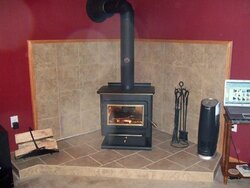The 1/3 is applied to the 13.5"/8.5" unshielded/shielded stove-wall distance given in the table (EDIT: this is wrong, only the 36" NFPA distance is reduced to 12"), so it's 4.5"/2.8" from the stove to the tile/durock if I understand correctly. Note the stovepipe still has to maintain 18 or 24.5" (double/single-wall respectively) from the unshielded sheetrock above the surround, or else the wall shield has to follow it up.
The manual is confusing, because it has the discussion of the wall shielding several pages after the table of clearances for unshielded, combustible walls. The table also combines the stovepipe-wall distance table with the stove-wall distance table, so, for instance, it has no entry for single-wall pipe installed on a shielded stove (only unshielded/single-wall and shielded/double wall). It could be written more clearly, in other words (hint, hint).
The wall shielding seems to reduce the space requirement considerably.
The manual is confusing, because it has the discussion of the wall shielding several pages after the table of clearances for unshielded, combustible walls. The table also combines the stovepipe-wall distance table with the stove-wall distance table, so, for instance, it has no entry for single-wall pipe installed on a shielded stove (only unshielded/single-wall and shielded/double wall). It could be written more clearly, in other words (hint, hint).
The wall shielding seems to reduce the space requirement considerably.



